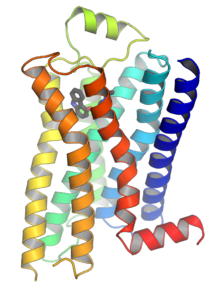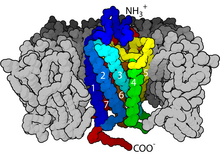หน่วยรับที่จับคู่กับจีโปรตีน
| GPCR | |||||||||
|---|---|---|---|---|---|---|---|---|---|
 หน่วยรับคือ beta-2 adrenergic receptor ของมนุษย์เมื่อรวมเป็นคอมเพล็กซ์กับยา carazolol ซึ่งมีฤทธิ์เป็น β-adrenergic receptor partial inverse agonist[1] | |||||||||
| ป้ายระบุ | |||||||||
| สัญลักษณ์ | 7tm_1 | ||||||||
| พีแฟม | PF00001 | ||||||||
| อินเทอร์โปร | IPR000276 | ||||||||
| PROSITE | PDOC00210 | ||||||||
| TCDB | 9.A.14 | ||||||||
| โอพีเอ็ม ซูเปอร์แฟมิลี | 6 | ||||||||
| โอพีเอ็ม โปรตีน | 1gzm | ||||||||
| |||||||||

หน่วยรับที่จับคู่กับจีโปรตีน (อังกฤษ: G protein-coupled receptors ตัวย่อ GPCRs) ที่มีชื่ออื่น ๆ อีกว่า seven-(pass)-transmembrane domain receptors, 7TM receptors, heptahelical receptors, serpentine receptor, และ G protein-linked receptors (GPLR), เป็นกลุ่ม (family) โปรตีนหน่วยรับ (receptor) กลุ่มใหญ่ ที่ตรวจจับโมเลกุลนอกเซลล์ แล้วจุดชนวนวิถีการถ่ายโอนสัญญาณ (signal transduction) ภายในเซลล์ ซึ่งในที่สุดมีผลเป็นการตอบสนองของเซลล์ เป็นหน่วยรับที่จับคู่กับจีโปรตีน (G protein) ที่เรียกว่า seven-transmembrane receptor เพราะมีโครงสร้างที่ข้ามผ่านเยื่อหุ้มเซลล์ถึง 7 ครั้ง[2]
GPCRs จะพบแต่ในยูแคริโอตรวมทั้งยีสต์, choanoflagellate[3], และสัตว์ ลิแกนด์ที่จับและเริ่มการทำงานของหน่วยรับเช่นนี้รวมทั้งสารประกอบไวแสง กลิ่น ฟีโรโมน ฮอร์โมน และสารสื่อประสาท โดยมีขนาดต่าง ๆ เริ่มตั้งแต่โมเลกุลเล็ก ๆ จนถึงเพปไทด์และโปรตีนขนาดใหญ่ GPCRs มีบทบาทในโรคหลายอย่าง และเป็นเป้าหมายการออกฤทธิ์ของยาปัจจุบันประมาณ 34%[4][5][6]
มีวิถีการถ่ายโอนสัญญาณสองอย่างเกี่ยวกับ GPCRs คือ[7]
- cyclic adenosine monophosphate (cAMP) signal pathway
- phosphatidylinositol signal pathway
เมื่อลิแกนด์จับกับ GPCR ก็จะทำให้หน่วยรับเปลี่ยนโครงรูปแบบ conformational change ซึ่งทำให้มีฤทธิ์เป็น guanine nucleotide exchange factor (GEF) แล้วสามารถเริ่มการทำงานของจีโปรตีน โดยแลกเปลี่ยน guanosine diphosphate (GDP) ที่ยึดกับจีโปรตีนกับ guanosine triphosphate (GTP) หน่วยย่อยแอลฟา (α subunit) ของจีโปรตีนบวกกับ GTP ที่ได้มาใหม่ ก็จะสามารถแยกตัวออกจากหน่วยย่อยบีตาและแกมมาแล้วออกฤทธิ์ต่อโปรตีนส่งสัญญาณภายในเซลล์อื่น ๆ หรือออกฤทธิ์โดยตรงต่อโปรตีนทำหน้าที่ (functional protein) ขึ้นอยู่กับชนิดของหน่วยย่อยแอลฟา (Gαs, Gαi/o, Gαq/11, Gα12/13)[8]: 1160
ประวัติและความสำคัญ[แก้]
รางวัลโนเบลสาขาเคมีปี 2012 ได้ให้กับงาน (ของ Brian Kobilka และ Robert Lefkowitz) ที่ "สำคัญต่อการเข้าใจว่า หน่วยรับที่จับคู่กับจีโปรตีนทำงานอย่างไร"[9] มีรางวัลโนเบลอย่างน้อย 7 รางวัลอื่น ๆ ที่ให้เกี่ยวกับการส่งสัญญาณที่อำนวยโดยจีโปรตีน[ต้องการอ้างอิง] โดยปี 2012 ยาที่ขายดีที่สุดในโลก 2 ชนิดจาก 10 ชนิดแรก คือ Fluticasone/salmeterol และ Abilify ออกฤทธิ์ที่หน่วยรับซึ่งจับคู่กับจีโปรตีน[10]
หมวดหมู่[แก้]

ขนาดหมู่ใหญ่ (superfamily) ของ GPCR ยังไม่ชัดเจน แต่การวิเคราะห์ลำดับจีโนมในมนุษย์พยากรณ์ว่า ยีนมนุษย์เกือบ 800 ยีน (หรือประมาณ 4% ของจีโนมที่เข้ารหัสโปรตีน) เข้ารหัส GPCR[11] แม้จะมีการจัดหมวดหมู่ที่เสนอมากมาย แต่โดยคลาสสิกแล้ว หมู่ใหญ่จะแบ่งออกเป็น 3 ชั้น (class) คือ A, B และ C โดยไม่มีต้นกำเนิดของลำดับ (sequence homology) ร่วมกันในระหว่างชั้น
ชั้นใหญ่สุดก็คือชั้น A ซึ่งรวมยีน GPCR เกือบ 85% ในชั้นนี้ เกินครึ่งพยากรณ์ว่า เข้ารหัสหน่วยรับกลิ่น ในขณะที่เหลือจะจับกับลิแกนด์ซึ่งเป็นสารประกอบภายในร่างกายที่รู้จัก หรือจะจัดเป็นหน่วยรับกำพร้า (orphan receptor คือยังไม่รู้ว่ามีลิแกนด์เป็นอะไร) แม้ชั้นต่าง ๆ จะไม่มีต้นกำเนิดของลำดับร่วมกัน แต่ GPCR ทั้งหมดก็มีโครงสร้างและกลไกถ่ายโอนสัญญาณที่เหมือนกัน ชั้นนี้ยังแบ่งออกเป็นชั้นย่อยอีก 19 กลุ่ม คือ A1-A19[12]
งานปี 2006 ได้เสนอระบบการจัดหมวดหมู่ทางเลือกที่เรียกว่า GRAFS (Glutamate, Rhodopsin, Adhesion, Frizzled/Taste2, Secretin)[11]
ส่วนตามระบบจัดหมู่เป็น A-F แบบคลาสสิก GPCR สามารถจัดเป็น 6 ชั้น อาศัยต้นกำเนิดลำดับและความคล้ายคลึงกันในการทำงาน[13][14][15][16]
- Class A (หรือ 1) (Rhodopsin-like)
- Class B (หรือ 2) (Secretin receptor family)
- Class C (หรือ 3) (Metabotropic glutamate/pheromone)
- Class D (หรือ 4) (Fungal mating pheromone receptors)
- Class E (หรือ 5) (Cyclic AMP receptors)
- Class F (หรือ 6) (Frizzled/Smoothened)
งานศึกษาอาศัยลำดับดีเอ็นเอต้น ๆ แสดงว่า จีโนมมนุษย์เข้ารหัส GPCR 750 ชนิดอย่างคร่าว ๆ[17] ประมาณ 350 ชนิดตรวจจับฮอร์โมน, growth factors, และลิแกนด์ที่เกิดในร่างกายอื่น ๆ ประมาณ 150 ชนิดมีหน้าที่ยังไม่ชัดเจน
มีวิธีการต่าง ๆ[18][19][20] ที่ใช้พยากรณ์หมวดหมู่ของ GPCR ตามลำดับกรดอะมิโนของพวกมันอย่างเดียว อาศัยแนวคิด pseudo amino acid composition
บทบาททางสรีรภาพ[แก้]
GPCR มีบทบาทในกระบวนการทางสรีรภาพต่าง ๆ เช่น
- การเห็น - โปรตีนไวแสง opsin จะเปลี่ยนไอโซเมอร์เมื่อรับแสง เพื่อแปลรังสีแม่เหล็กไฟฟ้าให้เป็นสัญญาณในเซลล์ เช่น Rhodopsin จะเปลี่ยนจาก 11-cis-retinal เป็น all-trans-retinal เนื่องกับกระบวนการนี้
- การรู้รส - GPCR ในเซลล์รับรส จะเริ่มการทำงานของจีโปรตีน คือ gustducin เพื่อตอบสนองต่อรสหวาน ขม และอุมะมิ
- การได้กลิ่น - หน่วยรับของเยื่อบุผิวรับกลิ่นคือ หน่วยรับกลิ่นจะจับกับโมเลกุลมีกลิ่น ในขณะที่ vomeronasal receptor จะจับกับฟีโรโมน
- การควบคุมพฤติกรรมและอารมณ์ - หน่วยรับในสมองสัตว์เลี้ยงลูกด้วยนมสามารถจับกับสารสื่อประสาทต่าง ๆ รวมทั้งเซโรโทนิน โดพามีน GABA (Gamma-aminobutyric acid) และกลูตาเมต
- การควบคุมการทำงานของระบบภูมิคุ้มกันและกระบวนการอักเสบ - หน่วยรับ Chemokine receptor จะจับกับลิแกนด์ที่อำนวยการสื่อสารระหว่างเซลล์ต่าง ๆ ของระบบภูมิคุ้มกัน หน่วยรับ เช่น หน่วยรับฮิสตามีน จะจับกับตัวอำนวยการอักเสบ (inflammatory mediator) และเริ่มการทำงานของเซลล์เป้าหมายชนิดต่าง ๆ ในการตอบสนองเป็นการอักเสบ GPCR ยังมีบทบาทในการปรับระบบภูมิคุ้มกัน และมีบทบาทโดยตรงในการยับยั้งการตอบสนองจากเซลล์ที (T cell) ที่ชักนำโดย TLR[21]
- การสื่อประสาทในระบบประสาทอิสระทั้งระบบประสาทซิมพาเทติกและระบบประสาทพาราซิมพาเทติก จะควบคุมโดยวิถีการส่งสัญญาณผ่าน GPCR ซึ่งมีบทบาทควบคุมระบบอัตโนมัติต่าง ๆ ในร่างกาย เช่น ความดันโลหิต อัตราการเต้นหัวใจ และการย่อยอาหาร
- การรับรู้ความหนาแน่นของเซลล์
- การปรับภาวะธำรงดุล (เช่นความสมดุลของน้ำ).[22]
- บทบาทในการเติบโตและแพร่กระจายของเนื้องอกบางอย่าง[23]
ดูเพิ่ม[แก้]
เชิงอรรถและอ้างอิง[แก้]
- ↑ Cherezov, V; Rosenbaum, DM; Hanson, MA; Rasmussen, SG; Thian, FS; Kobilka, TS; Choi, HJ; Kuhn, P; Weis, WI; Kobilka, BK; Stevens, RC (November 2007). "High-resolution crystal structure of an engineered human beta2-adrenergic G protein-coupled receptor". Science. 318 (5854): 1258–65. doi:10.1126/science.1150577. PMC 2583103. PMID 17962520.
{{cite journal}}: CS1 maint: uses authors parameter (ลิงก์) - ↑ Trzaskowski, B; Latek, D; Yuan, S; Ghoshdastider, U; Debinski, A; Filipek, S (2012). "Action of molecular switches in GPCRs—theoretical and experimental studies". Current Medicinal Chemistry. 19 (8): 1090–109. doi:10.2174/092986712799320556. PMC 3343417. PMID 22300046.
{{cite journal}}: CS1 maint: uses authors parameter (ลิงก์) - ↑ King, N; Hittinger, CT; Carroll, SB (July 2003). "Evolution of key cell signaling and adhesion protein families predates animal origins". Science. 301 (5631): 361–3. doi:10.1126/science.1083853. PMID 12869759.
{{cite journal}}: CS1 maint: uses authors parameter (ลิงก์) - ↑
Filmore, D (2004). "It's a GPCR world". Modern Drug Discovery. American Chemical Society. 2004 (November): 24–28.
{{cite journal}}: CS1 maint: uses authors parameter (ลิงก์) - ↑
Overington, JP; Al-Lazikani, B; Hopkins, AL (December 2006). "How many drug targets are there?". Nature Reviews. Drug Discovery. 5 (12): 993–6. doi:10.1038/nrd2199. PMID 17139284.
{{cite journal}}: CS1 maint: uses authors parameter (ลิงก์) - ↑ Hauser, Alexander S.; Attwood, Misty M.; Rask-Andersen, Mathias; Schiöth, Helgi B.; Gloriam, David E. (October 2017). "Trends in GPCR drug discovery: new agents, targets and indications". Nature Reviews Drug Discovery. doi:10.1038/nrd.2017.178. PMID 29075003. สืบค้นเมื่อ 7 November 2017.
- ↑ Gilman, AG (1987). "G proteins: transducers of receptor-generated signals". Annual Review of Biochemistry. 56 (1): 615–49. doi:10.1146/annurev.bi.56.070187.003151. PMID 3113327.
{{cite journal}}: CS1 maint: uses authors parameter (ลิงก์) - ↑ Wettschureck, N; Offermanns, S (October 2005). "Mammalian G proteins and their cell type specific functions". Physiological Reviews. 85 (4): 1159–204. doi:10.1152/physrev.00003.2005. PMID 16183910.
{{cite journal}}: CS1 maint: uses authors parameter (ลิงก์) - ↑ Royal Swedish Academy of Sciences (10 October 2012). "The Nobel Prize in Chemistry 2012 Robert J. Lefkowitz, Brian K. Kobilka". สืบค้นเมื่อ 10 October 2012.
- ↑ "The Top Prescription Drugs of 2012 Globally: Biologics Dominate, But Small Molecule CNS Drugs Hold on to Top Spots" (PDF). ACS Chemical Neuroscience. สืบค้นเมื่อ 3 February 2016.
- ↑ 11.0 11.1 11.2 Bjarnadóttir, TK; Gloriam, DE; Hellstrand, SH; Kristiansson, H; Fredriksson, R; Schiöth, HB (September 2006). "Comprehensive repertoire and phylogenetic analysis of the G protein-coupled receptors in human and mouse". Genomics. 88 (3): 263–73. doi:10.1016/j.ygeno.2006.04.001. PMID 16753280.
{{cite journal}}: CS1 maint: uses authors parameter (ลิงก์) - ↑ Joost, P; Methner, A (October 2002). "Phylogenetic analysis of 277 human G-protein-coupled receptors as a tool for the prediction of orphan receptor ligands". Genome Biology. 3 (11): RESEARCH0063. doi:10.1186/gb-2002-3-11-research0063. PMC 133447. PMID 12429062.
{{cite journal}}: CS1 maint: uses authors parameter (ลิงก์) - ↑
Attwood, TK; Findlay, JB (February 1994). "Fingerprinting G-protein-coupled receptors". Protein Engineering. 7 (2): 195–203. doi:10.1093/protein/7.2.195. PMID 8170923.
{{cite journal}}: CS1 maint: uses authors parameter (ลิงก์) - ↑
Kolakowski, LF (1994). "GCRDb: a G-protein-coupled receptor database". Receptors & Channels. 2 (1): 1–7. PMID 8081729.
{{cite journal}}: CS1 maint: uses authors parameter (ลิงก์) - ↑
Foord, SM; Bonner, TI; Neubig, RR; Rosser, EM; Pin, JP; Davenport, AP; Spedding, M; Harmar, AJ (June 2005). "International Union of Pharmacology. XLVI. G protein-coupled receptor list". Pharmacological Reviews. 57 (2): 279–88. doi:10.1124/pr.57.2.5. PMID 15914470.
{{cite journal}}: CS1 maint: uses authors parameter (ลิงก์) - ↑ "gpcr". InterPro.
- ↑ Vassilatis, DK; Hohmann, JG; Zeng, H; Li, F; Ranchalis, JE; Mortrud, MT; Brown, A; Rodriguez, SS; Weller, JR; Wright, AC; Bergmann, JE; Gaitanaris, GA (April 2003). "The G protein-coupled receptor repertoires of human and mouse". Proceedings of the National Academy of Sciences of the United States of America. 100 (8): 4903–8. doi:10.1073/pnas.0230374100. PMC 153653. PMID 12679517.
{{cite journal}}: CS1 maint: uses authors parameter (ลิงก์) - ↑
Xiao, X; Wang, P; Chou, KC (July 2009). "GPCR-CA: A cellular automaton image approach for predicting G-protein-coupled receptor functional classes". Journal of Computational Chemistry. 30 (9): 1414–23. doi:10.1002/jcc.21163. PMID 19037861.
{{cite journal}}: CS1 maint: uses authors parameter (ลิงก์) - ↑
Qiu, JD; Huang, JH; Liang, RP; Lu, XQ (July 2009). "Prediction of G-protein-coupled receptor classes based on the concept of Chou's pseudo amino acid composition: an approach from discrete wavelet transform". Analytical Biochemistry. 390 (1): 68–73. doi:10.1016/j.ab.2009.04.009. PMID 19364489.
{{cite journal}}: CS1 maint: uses authors parameter (ลิงก์) - ↑
Gu, Q; Ding, YS; Zhang, TL (May 2010). "Prediction of G-protein-coupled receptor classes in low homology using Chou's pseudo amino acid composition with approximate entropy and hydrophobicity patterns". Protein and Peptide Letters. 17 (5): 559–67. doi:10.2174/092986610791112693. PMID 19594431.
{{cite journal}}: CS1 maint: uses authors parameter (ลิงก์) - ↑ Sharma, N; Akhade, AS; Qadri, A (April 2013). "Sphingosine-1-phosphate suppresses TLR-induced CXCL8 secretion from human T cells". Journal of Leukocyte Biology. 93 (4): 521–8. doi:10.1189/jlb.0712328. PMID 23345392.
{{cite journal}}: CS1 maint: uses authors parameter (ลิงก์) - ↑ Hazell, GG; Hindmarch, CC; Pope, GR; Roper, JA; Lightman, SL; Murphy, D; O'Carroll, AM; Lolait, SJ (January 2012). "G protein-coupled receptors in the hypothalamic paraventricular and supraoptic nuclei—serpentine gateways to neuroendocrine homeostasis". Frontiers in Neuroendocrinology. 33 (1): 45–66. doi:10.1016/j.yfrne.2011.07.002. PMC 3336209. PMID 21802439.
{{cite journal}}: CS1 maint: uses authors parameter (ลิงก์) - ↑ Dorsam, RT; Gutkind, JS (February 2007). "G-protein-coupled receptors and cancer". Nature Reviews. Cancer. 7 (2): 79–94. doi:10.1038/nrc2069. PMID 17251915.
{{cite journal}}: CS1 maint: uses authors parameter (ลิงก์)
แหล่งข้อมูลอื่น[แก้]
- G-protein-coupled receptors ในหอสมุดแพทยศาสตร์แห่งชาติอเมริกัน สำหรับหัวข้อเนื้อหาทางการแพทย์ (MeSH)
- Vassilatis, DK; Hohmann, JG; Zeng, H; Li, F; Ranchalis, JE; Mortrud, MT; Brown, A; Rodriguez, SS; Weller, JR; Wright, AC; Bergmann, JE; Gaitanaris, GA (2003). "The G protein-coupled receptor repertoires of human and mouse". Proc. Natl. Acad. Sci. U.S.A. 100 (8): 4903–8. doi:10.1073/pnas.0230374100. PMC 153653. PMID 12679517.
{{cite journal}}: CS1 maint: uses authors parameter (ลิงก์) - "GPCR Reference Library". สืบค้นเมื่อ 11 August 2008.
Reference for molecular and mathematical models for the initial receptor response
- "The Nobel Prize in Chemistry 2012" (PDF). สืบค้นเมื่อ 10 October 2012.
- GPCR Cell Line
- "GPCR Database". IUPHAR Database. International Union of Basic and Clinical Pharmacology. คลังข้อมูลเก่าเก็บจากแหล่งเดิมเมื่อ 15 September 2008. สืบค้นเมื่อ 11 August 2008.
- "GPCRdb".
Data, diagrams and web tools for G protein-coupled receptors (GPCRs).
; Munk, C; Isberg, V; Mordalski, S; Harpsøe, K; Rataj, K; Hauser, AS; Kolb, P; Bojarski, AJ; Vriend, G; Gloriam, DE (2016). "GPCRdb: the G Protein-Coupled Receptor Database - an Introduction". British Journal of Pharmacology. 173 (14): 2195–207. doi:10.1111/bph.13509. PMC 4919580. PMID 27155948.{{cite journal}}: CS1 maint: uses authors parameter (ลิงก์) - "G Protein-Coupled Receptors on the NET". สืบค้นเมื่อ 10 November 2010.
a classification of GPCRs
- "PSI GPCR Network Center". คลังข้อมูลเก่าเก็บจากแหล่งเดิมเมื่อ 25 July 2013. สืบค้นเมื่อ 11 July 2013.
a Protein Structure Initiative:Biology Network Center aimed at determining the 3D structures of representative GPCR family proteins
